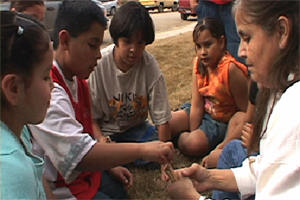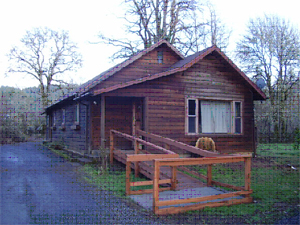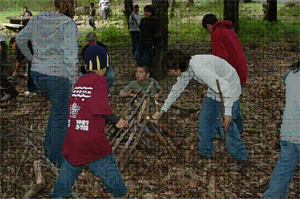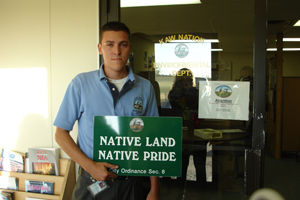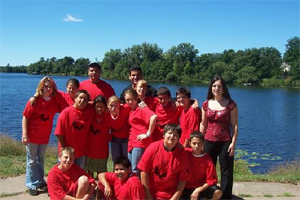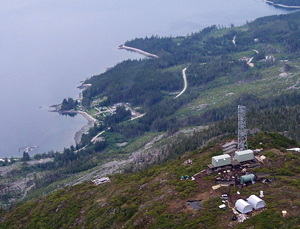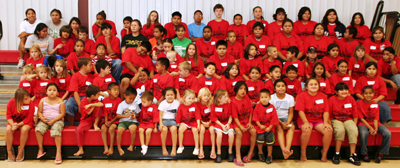2007 Success Stories
Project Title: Speaking White Clay Language Immersion Project
Project Start/End Dates: 9/30/2004 - 9/29/2007
Total Grant Amount: $517,997
“These 14 youth are now the strongest White Clay speakers on our reservation. They are held in such high regard that they are invited to speak at traditional ceremonies.”
-Lynnette Chandler, Project Director
The Fort Belknap Reservation spans 675,147 acres in northern Montana, and is the home of the Assiniboine (Nakoda) and Gros Ventre (White Clay) people. There are over 5,200 enrolled community members, of which 2,900 reside on the Reservation. At the time this project was proposed, about eight fluent White Clay speakers remained.
The Project’s purpose was to ensure the survival and vitality of the White Clay language by creating a Gros Ventre immersion classroom. Project staff convened an eight-member Advisory Board, consisting of elders and language program staff, which provided ongoing oversight and direction for the White Clay classroom. Two immersion classroom teachers were hired and provided professional development, including methodology. Project staff translated state curriculum into White Clay. Students were assessed informally in White Clay acquisition and formally in the Dynamic Indicators of Basic Early Literacy Skills (DIBELS), a standardized assessment tool used throughout the nation in elementary schools and Head Start programs. Over 150 community members participated in the 4-day immersion camp. Project staff and immersion students developed weekly programs delivered via the local Reservation-based radio station.
This Project serves as a replicable model for other Tribal communities. Annual test results for the immersion students demonstrated they were at or above grade level academically and fluent in White Clay. In fiscal year 2007, Project staff is implementing an ANA project to expand the immersion school to include 5th & 6th grade classrooms and to increase the number of children served.
The Confederated Tribes of the Grand Ronde (CTGR) Community’s reservation spans 9,800 acres in northwest Oregon. CTGR is composed of more than 20 Tribes and bands whose traditional lands included regions throughout western Oregon and northern California. The Tribe currently enrolls approximately 5,000 community members.
Need for this Project is evident in the high rate of methamphetamine (meth) abuse in Indian Country, the rate of recidivism, and the lack of traditional cultural methods utilized in the treatment of American Indian people with an addiction to meth. The goal for the Project was to provide methamphetamine prevention and transitional after-care services to Tribal members.
The prevention aspect involved over 400 Tribal members attending regular gatherings to assist those dealing with addictions and to educate those who were not dealing directly with a meth addiction. During a “Tools for Healing and Meth Prevention” conference over 100 participants from local schools, county and state agencies, and Oregon Tribes learned about the meth crisis and discussed the tools available to deal with the problems this crisis causes.The positions of Project Coordinator and Support Counselor were hired to work with Tribal members with meth addictions as they left prison or a treatment program. The program combines western and traditional medicines to treat participants. The Transition House offers a safe place for Tribal members to recover while receiving treatment services, engaging in cultural activities and reconnecting with Tribal members. The recidivism rate of the clients dropped from 25 percent to 5 percent.
The Support Counselor and Project Coordinator positions will be retained by the Tribe, and $285,000 has been set aside in the Tribe’s 2008 budget to continue the services offered by the Transition House.
Project Title: Development of Tribal Game and Non-Game Management Strategy for Hoopa Valley
Project Start/End Dates: 9/30/2004 – 6/30/2007
Total Grant Amount: $451,708
"Our goal with the youth in this project was to ensure that attitude changes toward hunting would happen.”
-John Higley, the Project Director
The Hoopa Valley Tribe is located in the Klamath-Trinity Mountains of northern California. Hoopa Valley is home to over 2,500 residents, of which nearly 2,300 are Native Americans of Hoopa, Karuk or Yurok origins.
The Project’s purpose was to establish a wildlife management plan and regulatory structure for the Hoopa Valley Tribe. The Tribe planned to base the management plan on a survey of four wildlife species of cultural or economic importance to the Tribe. The Project also aimed to develop a hunter education program based upon Tribal cultural values and animal biology.
This project helped the Hoopa Tribe manage and govern its natural resources in a sustainable manner supported by the community. Biological surveys conducted under this project will provide data for future management decisions pertaining to management of the Tribe’s natural resources. The wildlife monitoring standard operating procedures set the methodological precedent for the reservation.
The hunter education curriculum provided new and existing Tribal hunters with information on hunting safety, wilderness survival, and safe hunting practices. The new management strategy and education program promote sustainable deer populations. Healthy woodpecker and fisher populations will ensure the availability of regalia materials for the Tribal traditionalists. For all Hoopa Tribal members, the successful management of natural resources, and positive changes in hunting practices, will strengthen the area’s ecological balance, promoting spiritual and economic success.
To sustain the Project, the Tribe has committed $150,000 in annual funding towards the development of a Wildlife Management Department. The Department will dedicate part of its budget to the continuation of the hunter education program.
Project Title: Crossroads Theatre for Youth: "Community Transformation Through the Arts"
Project Start/End Dates: 9/1/2004 – 8/31/2007
Total Grant Amount: $1,090,970
“The Project is building bridges between generations.”
-Ipu Lefiti, a community member
Intersections Inc. is a non-profit faith-based organization founded in 2002 and based in American Samoa. The mission of Intersections, Inc. is to make lasting positive differences in the lives of families by empowering them to break the cycle of poverty by improving the physical, social and spiritual aspects of family life.
This Project focused on specific social issues faced by American Samoan youth. The current trend of social problems relate to substance abuse, child abuse, violence, teen pregnancy, poverty, and suicide. There is a great deal of concern within the community regarding cultural erosion and the conflict between traditional and contemporary customs.
This Project sought to raise public awareness about social issues through the use of community theater. The Project utilized this medium as a way to bring sensitive and often times taboo issues to light in the community. Overall, this Project sought to reach 80% of the population under the age of 25 in American Samoa.
Through the implementation of the Community Theatre for Youth (CTY) program the Project involved 100 youth in the writing and production of three original plays per year in American Samoa and Hawaii. These plays addressed concerns faced by local youth such as child abuse, the hazards of smoking, suicide, substance abuse and peer pressure. CTY performed the plays at schools, local events and churches.
This Project helped the community identify problems and bring them to the forefront of discussion. CTY performed plays for over 12,000 youth and 2,000 elders. It increased familial communication while still managing to maintain Samoan cultural traditions. Project staff noticed increased confidence and self-esteem in the junior performers.
Samoa’s government agencies hired the Junior Company to film public service TV spots. Churches and other community groups invited performances, increasing the reach of the Project and ensuring that the Project met the stated goal of reaching 80 percent of American Samoa’s youth.
Project Title: Kaw Nation Environmental Regulatory Enhancement Program
Project Start/End Dates: 9/30/2005 – 2/28/2007
Total Grant Amount: $117,764
“I’m proud to be part of this project. I think it’s really improving the community.”
-Renee Vickery, the trained food inspector
During the 1870s, the Kaw people lived in what is now Kansas when land seizures forced the Tribe’s relocation to its present territory in Oklahoma. Based near Kaw City, the Kaw Tribe has 2,777 enrolled members.
In 1994, the Tribe established the Kaw Nation Environmental Department (KNED) to address tribal environmental needs. In March 2005, KNED led a community meeting to receive input on environmental challenges facing the Tribe. Participants expressed concerns over existing illegal solid waste sites on the reservation and lack of food safety codes for four tribally-owned food resellers. Participants also encouraged KNED to monitor and assess the Tribe’s underground septic tanks and water wells.
The purpose of the Project was to enhance the Tribe’s environmental regulatory structure to address the community’s expressed environmental concerns. Staff created an Environmental Codes Committee (ECC), and then evaluated solid waste sites on the reservation. Collaboration between staff and the Tribe’s General Council and ECC resulted in a new solid waste code. A similar process was utilized to develop codes for the Tribe’s underground storage tanks and food safety. In conjunction with code development, KNED staff conducted reclamation efforts at illegal waste sites and posted signs to deter community members from dumping additional waste. The Kaw Tribal Council passed the solid waste code in May 2007, which went into effect immediately.Prior to the Project the Tribe received compliance warnings from the State of Oklahoma related to food service and underground storage tank monitoring. Since implementing the codes, the Tribe has not received any compliance warnings. KNED staff reported a dramatic, sustained reduction in littering within the community. If littering in the community continues its recent decline, fewer pollutants will enter the lake, resulting in cleaner water for county residents.
The Lac du Flambeau Tribe is located in northern Wisconsin on land that the Tribe has inhabited since 1745. The Tribe implemented the Youth Entrepreneurship Project for middle school and high school students. Unemployment and poverty within the community is high; by instituting this Project the Tribe hoped to spearhead the revitalization of the individual enterprises within the reservation. An additional benefit was that youth took part in leadership and community service, which helped promote civic and cultural responsibility.
The Project’s purpose was to offer business education activities to increase the leadership capacity and entrepreneurial skills of Lac du Flambeau youth. The Project included a summer session and sessions conducted during the academic year.
After the first summer training, the Project staff implemented feedback from first year participants. This included an increased focus on community service and more interactive classroom activities. The summer program saw a growth in program completion of 160 percent between the first and second years. Examples of the community service projects include a medicine plant garden at the Elders’ Center and a hiking trail around the reservation.
Through an elective course and an after-school option, the academic year portion of this program impacted 42 students over the course of 2 years. As part of the project, a video was created that featured Lac du Flambeau small business owners and native youth participants from the project. The video, along with the curriculum developed under the second objective, completed the toolkit portion of the project. Upon request, nearly 800 toolkits have been distributed to local schools, Tribal community centers, Tribal youth programs, and academic institutions.
Youth learned civic responsibility through community service activities, which included roadside cleanups on reservation lands and the construction of trash bins and picnic tables. Furthermore, the hiking trail and garden created through the activities of the Project’s first objective continue to be maintained by youth. The project will continue to abide by the tenets of what the Lac du Flambeau community calls its triple bottom-line: “Make revenue, be good for the community, and respect Mother Earth.”
Project Title: Native Language Preservation and Maintenance
Project Start/End Dates: 9/30/2006 – 9/29/2007
Total Grant Amount: $75,000
"This is the first time in ten years that our dialogue with the school district regarding language preservation has turned around. The effects should be monumental for the Reservation.”
-Cindy Catches, the Project Director
Founded in 1994, Oceti Wakan is a nonprofit Native American faith-based organization whose primary goal is the preservation of Lakota culture. The organization develops language books, CDs and school curricula to further its cultural preservation goals.
The purpose of the Project was to conduct a comprehensive language assessment to identify the status of the Lakota language on the Reservation and establish the community’s long-range language preservation goals. Identified goals included: immersion language schools; increased Lakota cultural instruction in public schools; focusing language instruction on conversational sentences; declaring a “state of language emergency” on the Reservation; and focusing on the youngest children on the Reservation, both within homes and those enrolled in the Head Start program.
By the Project’s end, staff had some significant findings to share. Language surveyors captured data for 2,157 households in 9 districts throughout the Reservation. This sampling was representative of over 9,450 residents. The survey results indicated that 19 percent of Pine Ridge residents speak the Lakota language. In 41 percent of all the Reservation households, at least one person speaks Lakota.The community was positively impacted by the Project. Staff noted the following outcomes: a shift in consciousness regarding language preservation; elders who expressed concerns about rapid language loss felt the Project encouraged younger Tribal members to resolve language loss issues; and significant progress in the Reservation’s schools.
The Organized Village of Kasaan, the oldest Haida village in Alaska, was established in 1934 and is one of four Tribes located on Prince of Wales Island in Southeast Alaska. The remote location of Kasaan has a significant impact on the community, as it directly affects the cost of supplies, transportation options, and other basic goods and services.
Due to the closure of both the cannery and mill in 1973, and the more recent closures of the Ketchikan Pulp facilities on the island, the Tribe and community struggled with problems of unemployment and out-migration. The Project aimed to address these needs through capacity building to improve economic opportunities for local Tribal members and the development of an economic plan to direct the Tribe’s growth and define infrastructure needs.
The Tribe now has a path to navigate towards economic self-sufficiency, a strong infrastructure to ensure achievement of goals and trained staff to provide future guidance. The Project developed new policies and procedures and modified the constitution and by-laws, providing the Tribe with infrastructure and accountability to its members.
The development of an Overall Economic Development Plan supplies the Tribe with a blueprint for future endeavors—such as eco-tourism enterprises, an aquaculture farm, and housing and real estate developments—aimed at increasing economic development. The Tribe has acquired cellular telephone service as a result of a new cellular tower. Community members and Project staff indicated these outcomes have provided the community and Tribe with a sense of pride.
The Pueblo of Laguna Reservation encompasses 533,000 acres of land situated 45 miles west of Albuquerque, New Mexico. The reservation is currently home to over 4,200 Pueblo community members concentrated in six villages: Laguna, Mesita, Paguate, Encinal, Seama, and Paraje.
The goal of the Project was to transition from a Tribally-run water, wastewater, and solid waste utility service to a stand-alone, self-sustaining Utility Authority (UA). The establishment of the UA makes funds available to the Tribe for other critical areas such as road development.
In the previous arrangement, the Tribe was paying 100 percent of these utility fees for commercial and residential users. In an effort to help community members adjust, the UA staff has developed a five-year plan in which the initial financial burden of the consumer is 20 percent. The portion of responsibility will increase every year, until the consumer is paying the entire utility fee. A sliding fee scale has been instituted for those with a fixed income.
This Project has advanced the Tribe’s ability to efficiently and effectively manage utilities within the service area. The centralized infrastructure of the UA has improved the services offered, via the implementation of a plan for preventative maintenance on water towers and associated infrastructure. The $824,142 in fees collected by the UA during the Project timeframe allows it to be self-sustaining, thereby continuing to improve services to customers.
The UA has also begun conservation efforts; a community outreach effort was conducted to educate people on the importance of conservation. Studies are being launched on renewable sources of energy, such as wind. The UA was also awarded a USDA grant to provide broadband access to all six Pueblo communities, further signifying their strengthened capacity.
Members of the Sac and Fox Tribe are descendents of the Sauk and Fox, two Algonquian-speaking peoples of the Great Lakes region. The two Tribes were historically independent, but closely related in culture and language. Sac and Fox Tribal lands are dispersed throughout Lincoln, Payne, and Pottawatomie counties of north-central Oklahoma. The Tribe has 3,356 enrolled Tribal members, 2,275 of whom live in Oklahoma.
Both the Sac and Fox originate from the Sauk language. In 2006, the Sac and Fox Nation created a Sauk Language Department (SLD) to direct language preservation efforts.
The purpose of the Project was to conduct a Sauk language assessment to engage the entire Sac and Fox Tribal membership while creating support for a sustainable immersion language program. The Project methodology focused on participatory community outreach and planning.
The Project promoted opportunities for intergenerational exchange during 28 language and culture-focused community activities carried out in the year. Staff conducted a five-day pilot immersion camp for tribal 3-4 year olds to demonstrate the technique’s effectiveness. Staff reported that many parents of children attending the immersion camp became “instant converts” to the method after witnessing their children speaking basic Sauk words and phrases after only three or four days in the class.
Through a survey process, the tribal community developed a clear sense of how Sauk people feel about their language and revitalization efforts. Survey data showed the vast majority of Sac and Fox tribal members want to preserve the Sauk language. The Project’s language immersion education efforts ensure community support.
Spruce Island Development Corporation (SIDCO) is a non-profit corporation formed in 2004 by the joint efforts of the City of Ouzinkie, the Native Village of Ouzinkie and Ouzinkie Native Corporation.
Regulations on fishing and declining fish prices have had a significant negative impact on the community, as the community relies primarily on commercial fishing. This project sought to increase employment opportunities for community members through an inclusive planning effort. This effort focused on an investigation into the feasibility of developing support for five industries: community quota entities, small fish processing, transportation, tourism, and behavioral health services.
Project goals were surpassed. The results included training of 43 individuals, finalizing the Economic Development and Integrated Business Plan, and creating an accounting system to fulfill federal financial reporting requirements. Training session participants voiced approval of Project outcomes. Verna Bennet, Tribal Secretary, stated, “Each training session gave the community ideas on what exactly must be done in order for our projects to start and what steps must be taken to ensure sustainability.” Roberta Townsend-Vennel, the Project’s business consultant, concluded, “Ouzinkie can now function as a business with its community members as its experts.”
The adoption of the Business Plan by Tribal Council signifies that Ouzinkie now has a documented vision to focus and facilitate efforts to revitalize the economy that is fully reflective of community members’ wants and needs. The completed Plan will also provide foundational data for all SIDCO’s future funding requests. Since the vision of the project is a community vision and members are now the trained experts, the success of this plan should be far reaching.




